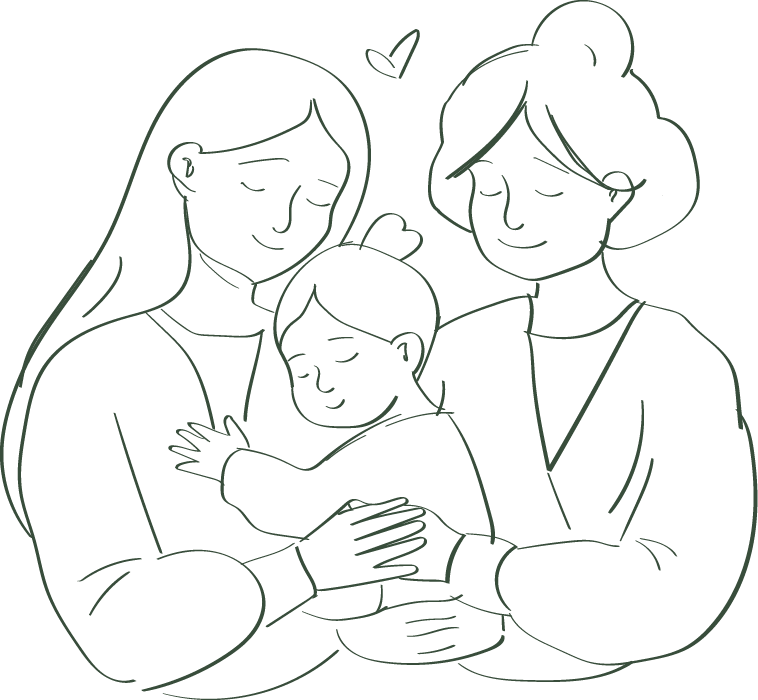
from Valentin Dinges | 17.01.2025 | 12 min reading time
Security - feeling safe, loved, warm, cared for, seen and looked after - is a great longing for many of us that accompanies us and that we seem unable to satisfy completely. Perhaps we have already tried the perfect morning routine, better goal setting or personal development. But perhaps all of this leaves a bland, inauthentic aftertaste - and does it really give us a deep sense of security? And when moments of security, inner safety and calm do arise, we often don't know why; and perhaps these moments quickly pass again. So what is it that gives us a sense of security? And above all: how can we take care of feeling secure in our own lives?
Disclaimer: I am assuming here that you are not in acute physical or emotional danger and that your basic needs are met. If you are a victim of structural social discrimination or violence, other aspects that are not discussed in this article may be more important and helpful.
We can find the answer if we imagine the following situation: you have a five-year-old child, but you are mainly preoccupied with yourself and your thoughts. Perhaps you are (for good reasons) primarily interested in your own well-being and hope above all that she is quiet and well-behaved. This makes you emotionally unavailable to your child or makes you seem cold, unreliable in your affection and structurally absent. What do you think your child will feel? Security? Will it feel safe with you, loved by you, connected to you and cared for by you?
The same applies to the quality of the relationship you have with yourself: do you feel secure, safe and loved in your life? If not, it may be because you are not yet giving yourself the kind of attention you need. It's because it's even more important to you not to feel your difficult feelings than to be committed to your well-being, you're not emotionally available to yourself and you don't know how to take responsibility for your feelings. This may sound very drastic, but it is!
That is why we use the Inner child work the image of the inner child: because it helps us to learn how to take good care of ourselves. And as a result of this self-effective self-care, we experience what we so desperately want: Security, safety, love, connectedness and peace. And this is the basis from which we learn to give ourselves joy, meaning, fulfillment and lasting happiness through our self-care. So if we long for security, the answer is: reliable, self-effective self-care!
To explain what I mean by "reliable, self-efficacious self-care", let me first explain what I mean by self-efficacy here. I mean your confidence that you can master the challenging life task of taking care of yourself comprehensively and well. Because your security, your connectedness, your joy and your happiness are based on this trust in your self-care. As this trust in yourself grows, you learn the kind of self-care I'm talking about; beyond feel-good bubble baths and wellness weekends. You experience your power to stand independently and fully in life, to face the challenges of your life, to grow with them, and to actively take care of your well-being, your security, your joy and your happiness.
The opposite of this is the powerlessness and forlornness that we feel when we feel structurally overwhelmed by our life and its challenges. When we believe that all we need is a better partner with whom we can finally feel secure. Or when we have overcome one situation but are thrown off course again by the next one and believe that someone else has to save us. How many years have we spent feeling powerless? How long have we felt lost and overwhelmed? And when will we learn structural self-care that will help us move forward? Because that is my sincere intention: to support you in learning to be there for yourself in a self-effective way so that you can benefit from the support of my Workshops or Coachings no longer need. Until then, I'm here to support you in the process, because yes, it can be challenging!
So what is this self-care I'm talking about? It means taking proactive and comprehensive care of your own wellbeing - physically, emotionally, in your relationships, your actions, and every other area of your life. True self-care requires that we take a deep look at our needs and feelings and take responsibility for our own well-being. It is an active, conscious practice that goes far beyond short-term reassurance.
And this is where inner child work comes into play: it offers us a method for structurally developing self-care. Inner child work aims to help us learn to take comprehensive care of ourselves! The inner child is just an image that helps many people to realize that they are responsible for their own feelings - because children are emotional and need our attention. However, if the image doesn't resonate with you, you can simply talk about your feelings instead of your inner child.
When we Internalize inner child workIt becomes our habit to move back into security, peace, joy and happiness when we encounter difficult situations, emotional pain and adversity in life. Through inner child work, we develop our inner resources and problem-solving skills, which sustainably support us in being there for ourselves in future situations. We learn how to support ourselves without becoming dependent on external help or seeking short-term solutions that do not fulfill us. As a result, we not only experience a deeper sense of security, but over time our confidence in our own ability to care for ourselves and bring us joy, happiness and fulfillment grows.
So what are we waiting for? Maybe you think self-care is selfish. We are often taught that we should look after others first and that it is wrong to put our own needs first. But is it really selfish to look after yourself? How can we be there for others when we ourselves are exhausted and unfulfilled? Self-care is not selfish - it is necessary. It is the basis for us being able to be there for others at all, authentically, lovingly and with a sense of security.
Or your feelings are filled with shame - social norms or your upbringing have blocked your path to yourself. Many of us have learned to suppress our feelings and conform in order to meet the expectations of others. We may be ashamed of taking ourselves seriously or admitting our anger and sadness. But therein lies the key to moving forward: learning to recognize and address our feelings. All your feelings are connected, you can't separate them, just like you can't separate the feelings of a child: If you don't feel your sadness and your anger, the path to true joy and security will probably also be blocked.
If you like, let's park these old beliefs for a moment and allow ourselves to see beyond them. Then we can make space for the question: So how do we really take good care of ourselves and learn self-care? Because self-care is a skill that we can learn, step by step.
Let me introduce you to the 6 steps of inner child work according to Dr. Margaret Paul and Dr. Erika Chopich ("Reconciliation with the inner child") - they are a simple method that you can learn to integrate self-care into your everyday life:
The point is not to see these steps as a one-off action, but as a daily practice. By taking small but consistent steps, you create a deeper connection to yourself and build an inner safety and security that will sustain you in the long term. Every small decision to lovingly care for yourself is a step towards more security, which communicates to your inner child that it is important to you and that you want to take good care of it.
I would like to tell you about Paula (name changed), one of my clients who already knew about inner child work, but only really learned to appreciate it after a crisis. After the sudden and unforeseen separation from her partner after 20 years of relationship, her life suddenly felt empty and insecure. The familiar security of her relationship disappeared from one moment to the next, and Paula was faced with an emotional abyss.
Fortunately, Paula already had experience with inner child work, which we had previously deepened in individual sessions, and decided to consistently integrate this method into her everyday life from then on - it was the best thing available to her. She dealt with her feelings on a daily basis, became aware of her inner child's injuries and began to lovingly give herself the care and security she needed. Through the inner child work, she found exactly the ways that worked specifically for her.
Through this conscious decision to make inner child work a daily practice, Paula experienced an amazing change: she told me: "I feel stronger, calmer and more confident inside - not because my external situation has changed, but because I am cultivating a new kind of self-care!" She found the security she had sought for so long in relationships through her contact with herself and her determination to take good care of herself. Today, Paula says that this crisis became an opportunity to make inner child work a fundamental way of life - a decision that helped her to find a deeper inner security that she had not known before.

I am not a therapist and my inner child coaching is not a substitute for medical or therapeutic treatment. I am someone who has been walking this path of inner child work myself for many years, speaking from my own experience and trained by the team of Dr. Margaret Paul and Dr. Erika Chopich to coach clients with inner child work. I would like to share with you the tools that have helped me to develop more self-care through inner child work and to lead a more fulfilling and secure life. My aim is to support you in going your own way independently and confidently - without becoming dependent on external help (including mine).
What can you expect from our coaching? Together we will work on strengthening your self-efficacy. I will show you how you can use the methods of inner child work independently to overcome challenges and promote your well-being. We will look at how you can integrate the six steps of inner child work into your everyday life - so that you can be there for yourself and fulfill your needs even in difficult moments.
Illustrations (c) Valentin Dinges.

I am Valentin Dinges, a qualified engineer, facilitator for inner child work according to Dr. Margaret Paul, coach and trainer for non-violent communication.
I will help you to see things more clearly again and to understand and categorize your feelings.
Take the first step now and book a Introductory meeting with me!
You can work with me in person in Aachen or online.
Sign up for the newsletter and stay up to date on seminars, courses, events and articles.
My inner child coaching can show you new perspectives and design possibilities and give you impulses for your personal development. I do not promise a cure, I do not treat or diagnose symptoms or illnesses, because I am not a therapist or doctor. Our work together complements, but does not replace, a visit to a doctor or therapist. In the case of physical complaints, you should always have an organic cause clarified.
I use female and male personal designations alternately.
Sign up for the newsletter
(c) Valentin Dinges, 2024.
To provide you with an optimal experience, we use technologies such as cookies to store and/or access device information. If you consent to these technologies, we may process data such as browsing behavior or unique IDs on this website.